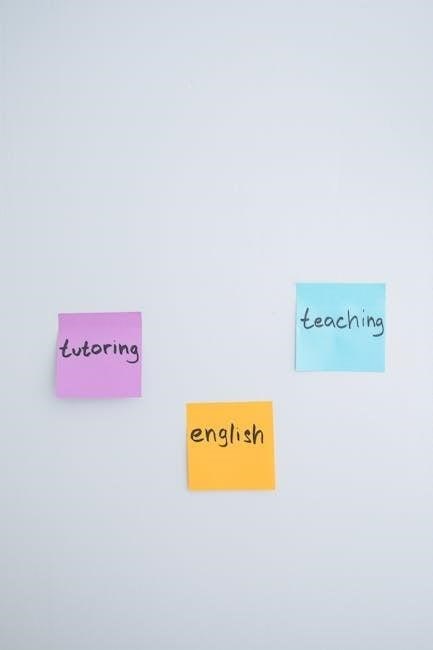Grade 3 English worksheets are designed to help young learners master essential skills in reading, writing, grammar, and vocabulary. These structured activities align with curricula like CBSE, NCERT, IB, and Common Core, ensuring comprehensive learning. Engaging and interactive, they cater to diverse learning styles, fostering academic growth and confidence in students.
Overview of English Learning in Grade 3
Grade 3 English learning focuses on building foundational skills in reading, writing, grammar, and vocabulary. Students explore structured activities that enhance comprehension, creativity, and communication. Worksheets play a key role in reinforcing lessons, offering engaging exercises that cater to diverse learning styles. These resources align with curricula like CBSE, NCERT, IB, and Common Core, ensuring comprehensive coverage of language skills. Interactive tasks and creative writing encourage students to express ideas confidently, fostering a deeper understanding of English while keeping them motivated and curious about learning;
Importance of Worksheets in English Learning
Worksheets are a vital tool in Grade 3 English learning, providing structured practice to reinforce grammar, vocabulary, and writing skills. They offer a comprehensive way to assess understanding and track progress. With engaging activities tailored to diverse learning styles, worksheets cater to both creative and analytical thinking. Regular use of high-quality worksheets aligns with curricula like CBSE and Common Core, ensuring students build confidence and fluency in English. They also promote independent learning, allowing children to practice at their own pace and develop essential language skills effectively.

Grammar Skills Covered in Grade 3
Grade 3 English worksheets cover key grammar skills, including nouns, verbs, adjectives, punctuation, and sentence structure. Structured exercises help students build a strong foundation in English grammar effectively.
Nouns: Common and Proper
Grade 3 English worksheets emphasize understanding common and proper nouns. Common nouns refer to general categories, like cat or city, while proper nouns name specific people, places, or things, such as John or London. Worksheets often include exercises where students identify and categorize nouns, using activities like matching games, fill-in-the-blanks, and sentence creation. These activities help reinforce the concept of capitalization for proper nouns and the correct usage of common nouns in sentences. By practicing with engaging worksheets, students develop a strong grasp of nouns, enhancing their overall grammar skills effectively.
Verbs: Action and Linking
Grade 3 English worksheets focus on teaching students to identify and use action and linking verbs effectively. Action verbs describe what someone or something is doing, such as run or write. Linking verbs, like be or seem, connect the subject to more information. Worksheets include exercises like identifying verbs in sentences, creating action verb sentences, and recognizing linking verbs. These activities help students understand how verbs function in language, improving their sentence structure and grammar skills. With practice, they become more confident in using verbs accurately in their writing and communication.
Adjectives: Describing People, Places, and Things
Grade 3 English worksheets introduce students to adjectives, which are words that describe people, places, and things. Worksheets include activities such as identifying adjectives in sentences, creating descriptive phrases, and matching words to pictures. Exercises focus on comparing sizes, emotions, and qualities, like big, happy, or colorful. These activities help students understand how adjectives enhance descriptions, making language more vivid and engaging. By practicing with worksheets, learners improve their ability to use adjectives effectively in sentences, fostering better communication and creative writing skills.

Reading Comprehension Activities
Reading comprehension activities in Grade 3 English worksheets foster essential skills through engaging short stories, poems, and informational texts, enhancing understanding and retention for young learners.
Short Stories for Grade 3
Short stories in Grade 3 English worksheets are engaging tools that help students develop reading comprehension and critical thinking skills. These narratives, often featuring relatable themes and characters, encourage young learners to explore imaginative worlds while understanding plot, setting, and moral lessons. Worksheets typically include questions that prompt students to identify main ideas, infer meanings, and analyze characters. This structured approach ensures that pupils not only enjoy the stories but also improve their ability to interpret and retain information effectively. Such activities are carefully designed to align with curriculum standards like CBSE and NCERT, making them both educational and enjoyable for Grade 3 students.
Poetry and Rhyming Texts
Poetry and rhyming texts in Grade 3 English worksheets introduce students to the rhythm and creativity of language. These activities help pupils recognize rhyming patterns, syllables, and word families, enhancing phonological awareness. Worksheets often feature simple yet engaging poems that encourage memorization and recitation, fostering a love for literature. Comprehension questions and creative tasks, such as illustrating favorite lines, reinforce understanding and imagination. These exercises are tailored to meet educational standards, making poetry a fun and effective learning tool for young students while aligning with curricula like CBSE and NCERT.
Informational Texts and Non-Fiction
Grade 3 English worksheets often include informational texts and non-fiction passages to build comprehension skills. These texts introduce students to factual content, such as science, history, or animals, while reinforcing vocabulary and critical thinking. Worksheets typically feature short, engaging articles followed by questions to assess understanding. Activities may involve identifying main ideas, supporting details, and making inferences. These exercises help students develop the ability to analyze and interpret non-fiction texts, a crucial skill for academic success, while aligning with educational standards like CBSE and NCERT.

Writing Skills Development
Grade 3 English worksheets focus on improving writing skills through creative and functional exercises. Students practice composing stories, essays, and descriptive texts, enhancing their ability to express ideas clearly and coherently.
Creative Writing: Stories and Essays
Creative writing is a cornerstone of Grade 3 English learning, fostering imagination and self-expression. Worksheets often include prompts for crafting short stories, essays, and descriptive paragraphs, allowing students to explore different narrative styles and themes. These exercises encourage the development of plot, character, and setting, while also refining grammar and vocabulary usage. By providing structured yet flexible opportunities for creative expression, these activities help students build confidence and fluency in their writing abilities, preparing them for more complex literary tasks in higher grades.
Functional Writing: Letters and Descriptions
Functional writing focuses on practical communication skills, such as writing letters and descriptive texts. Worksheets provide structured templates for students to practice writing friendly or formal letters, including addressing envelopes and using proper salutations. Descriptive writing activities guide students to detail objects, scenes, or events using vivid language. These exercises enhance clarity, organization, and the ability to express thoughts effectively. They also help students understand the purpose and structure of everyday writing, preparing them for real-life communication scenarios while improving grammar and vocabulary usage in a practical context.

Vocabulary Building
Vocabulary building is essential for effective communication. Worksheets introduce new words through exercises like word lists, matching games, and sentence completion, helping students expand their lexicon and improve reading comprehension and writing skills. Interactive activities ensure engagement, making learning fun and impactful. Regular practice strengthens memory retention and application of words in various contexts, fostering confidence in language use. This skill is vital for overall academic success and lifelong learning.
Word Recognition and Spelling
Word recognition and spelling exercises in Grade 3 English worksheets help students identify and write words accurately. Activities like tracing, matching, and fill-in-the-blanks improve decoding skills and memorization. Worksheets often include high-frequency sight words and themed vocabulary, such as animals or food, to make learning engaging. These exercises enhance reading fluency and writing precision, building a strong foundation for language proficiency. Regular practice with spelling drills and word-building games fosters confidence and accuracy, preparing students for more complex texts and expressions in higher grades.
Synonyms and Antonyms
Learning synonyms and antonyms in Grade 3 English worksheets enhances vocabulary and comprehension. Activities include matching words, filling in blanks, and creating sentences. Worksheets often feature word pairs like happy/sad or big/small, helping students understand opposites and related meanings. These exercises improve critical thinking and language precision. By identifying synonyms and antonyms, students expand their word choices, boosting their ability to express ideas clearly. This skill is essential for effective communication and advanced reading comprehension in later grades.
Word Families and Patterns
Grade 3 English worksheets often focus on word families and patterns to build phonological awareness. Word families, like -at, -an, -in, help students recognize common letter combinations. Worksheets include matching games, word sorting, and filling in the blanks; These activities enhance decoding skills and spelling abilities. By identifying patterns, students can predict word meanings and read unfamiliar words more confidently. This foundational skill strengthens vocabulary and prepares learners for more complex reading and writing tasks in higher grades.

Punctuation and Capitalization
Grade 3 worksheets focus on correct punctuation and capitalization. Students learn to use commas, exclamation points, and question marks. Capitalization rules for sentences, names, and titles are emphasized. Worksheets include sentence completion and error detection exercises to reinforce these skills, ensuring proper punctuation and capitalization in writing. This builds a strong foundation for clear and accurate communication.
Periods, Commas, and Question Marks
Grade 3 worksheets introduce students to fundamental punctuation marks. Periods end declarative sentences, while commas separate items or phrases. Question marks denote inquiries. Worksheets include exercises like identifying correct punctuation in sentences, creating sentences with specific marks, and rewriting sentences with missing punctuation. Activities are designed to help students understand context and tone. Interactive exercises, such as matching games, reinforce learning. These skills are essential for clear and effective communication, laying a solid foundation for advanced writing. Worksheets provide structured practice, ensuring mastery of punctuation basics. They align with curriculum goals and promote confidence in writing abilities.
Capital Letters: Rules and Exceptions
Grade 3 worksheets focus on teaching the correct use of capital letters. Students learn to capitalize the first word of sentences, names of people, places, and holidays. Exceptions, like small words in titles, are also introduced. Worksheets include exercises such as identifying capital letters in sentences, writing names with proper capitalization, and correcting sentences with capitalization errors. Activities often involve fill-in-the-blank and matching games to reinforce understanding. These exercises help students grasp capitalization rules and apply them accurately in their writing. Practice worksheets ensure mastery of this essential skill for clear communication.

Benefits of Using Worksheets
- Worksheets improve grammar, vocabulary, and spelling skills effectively.
- They enhance reading comprehension and writing abilities in students.
- Regular practice boosts confidence and makes learning engaging.
Improved Grammar and Vocabulary
Grade 3 English worksheets PDFs are designed to strengthen grammar and vocabulary skills through structured exercises. Activities focus on identifying and using parts of speech, such as nouns, verbs, and adjectives, correctly. Worksheets often include sentence formation, word matching, and fill-in-the-blank exercises to enhance understanding. Vocabulary building is emphasized through word recognition, spelling practice, and context-based learning. Regular use of these worksheets helps students grasp grammar rules and expand their vocabulary, laying a strong foundation for effective communication. Consistent practice fosters confidence and fluency in language use.
Enhanced Reading and Writing Skills
Grade 3 English worksheets PDFs include activities designed to improve reading and writing abilities. Reading comprehension exercises focus on understanding short stories, poems, and informational texts, while writing prompts encourage creative expression through essays and narratives. Worksheets often feature structured writing tasks, such as completing sentences or composing short paragraphs, to help students organize their thoughts effectively. These exercises build confidence, improve sentence structure, and enhance critical thinking skills, preparing students for more complex language tasks in higher grades.
- Develops fluency in reading and writing.
- Encourages creative and structured writing practices.
- Strengthens comprehension and critical thinking.
Engagement and Motivation for Learning
Grade 3 English worksheets PDFs are designed to captivate young learners, fostering a love for language through engaging activities. Colorful visuals, interactive tasks, and fun exercises make learning enjoyable. Worksheets often include puzzles, word games, and creative writing prompts that spark curiosity. By providing a sense of accomplishment with each completed task, these resources motivate students to explore and practice English regularly. The variety of activities keeps learners interested, turning language learning into an exciting adventure rather than a chore.
- Uses colorful visuals and interactive tasks.
- Incorporates puzzles and word games for fun.
- Encourages creativity through writing prompts.

Curriculum Alignment
Grade 3 English worksheets align with CBSE/NCERT syllabus and international curricula like IB and Common Core, ensuring comprehensive learning and skill development.
CBSE/NCERT Syllabus Coverage
Grade 3 English worksheets are designed to align perfectly with the CBSE/NCERT syllabus, ensuring comprehensive coverage of all prescribed topics. These worksheets focus on building foundational skills in grammar, reading, and writing, as outlined in the curriculum. They include exercises on nouns, verbs, adjectives, and punctuation, along with reading comprehension and creative writing tasks. The worksheets are structured to follow the syllabus progression, starting from basic concepts and gradually introducing more complex topics. This alignment ensures that students can practice and master the exact skills taught in their classrooms. Regular practice with these worksheets helps students stay ahead and perform well in exams.
International Curricula: IB and Common Core
Grade 3 English worksheets are also aligned with International Baccalaureate (IB) and Common Core standards, catering to global educational frameworks. These worksheets incorporate critical thinking, creativity, and interdisciplinary learning, as emphasized in IB. For Common Core, they focus on building strong foundational skills in reading, writing, and speaking. Activities include analyzing texts, writing essays, and solving word problems, ensuring students meet international benchmarks. The structured exercises adapt seamlessly to diverse curricula, providing a comprehensive learning experience for students worldwide.

How to Use Worksheets Effectively
To use Grade 3 English worksheets effectively, establish a consistent routine, provide constructive feedback, and encourage self-correction. This approach fosters independence and improves learning outcomes.
Creating a Daily Routine
Establishing a daily routine with Grade 3 English worksheets helps students develop consistency and discipline. Begin with short, focused sessions of 15-20 minutes, gradually increasing as attention spans grow. Start with word recognition and spelling exercises, followed by grammar or comprehension tasks. Incorporate a mix of activities, such as creative writing or reading passages, to keep engagement high. Set specific times for practice, ensuring it becomes a habit; Consistency reinforces learning and builds confidence over time. Make it enjoyable by varying the tasks and celebrating small achievements to keep motivation strong. Regular practice yields lasting progress in English skills.
Providing Feedback and Encouragement
Positive feedback and encouragement are vital for young learners using Grade 3 English worksheets. Always acknowledge effort and progress, no matter how small. Use specific praise, like “Great job on spelling that word correctly!” to build confidence. Immediate feedback helps students understand mistakes and improve quickly. Tailor your comments to individual needs, focusing on strengths and areas for growth. Encourage self-improvement by setting achievable goals and celebrating successes. This supportive approach fosters a love for learning and motivates students to keep practicing. Regular encouragement helps children stay engaged and confident in their abilities.
Encouraging Self-Correction
Teaching students to self-correct while using Grade 3 English worksheets fosters independence and accountability. Begin by creating a simple checklist of common errors, such as spelling mistakes or punctuation omissions. Encourage students to review their work before submission, using highlighters to mark corrections. Visual reminders, like mnemonics or posters, can help them remember rules. Make it engaging by incorporating games or activities that focus on error detection. Praising their efforts to self-correct builds confidence and responsibility, helping them develop critical thinking skills. This practice ensures long-term retention of learning objectives.

Resources for Grade 3 Worksheets
Explore free PDFs on platforms like Teachers Pay Teachers and Education.com. Paid resources offer comprehensive curriculum-aligned content, ensuring structured learning for young students effectively and efficiently.
Free Printable Worksheets Online
Access a wide range of free printable Grade 3 English worksheets in PDF format from trusted websites like Education.com and Teachers Pay Teachers. These resources cover grammar, reading comprehension, and vocabulary building. Designed for curriculum alignment, they include activities like word searches, crossword puzzles, and short passages for practice. Parents and educators can download and print these worksheets easily, making learning fun and accessible at home. Many websites also offer answer keys and interactive content to enhance the learning experience for students.
Purchasing Worksheets: Where and How
Grade 3 English worksheets in PDF format can be purchased from various online platforms such as Amazon, Etsy, and Educents. These websites offer a wide range of worksheet bundles tailored to grammar, reading, and writing skills. Many sellers provide comprehensive packs that cover the entire curriculum, making it easy to find resources for specific topics. Payments are typically secure, and worksheets are available for instant download. Parents and teachers can also filter by price and content to find the most suitable options for their needs.